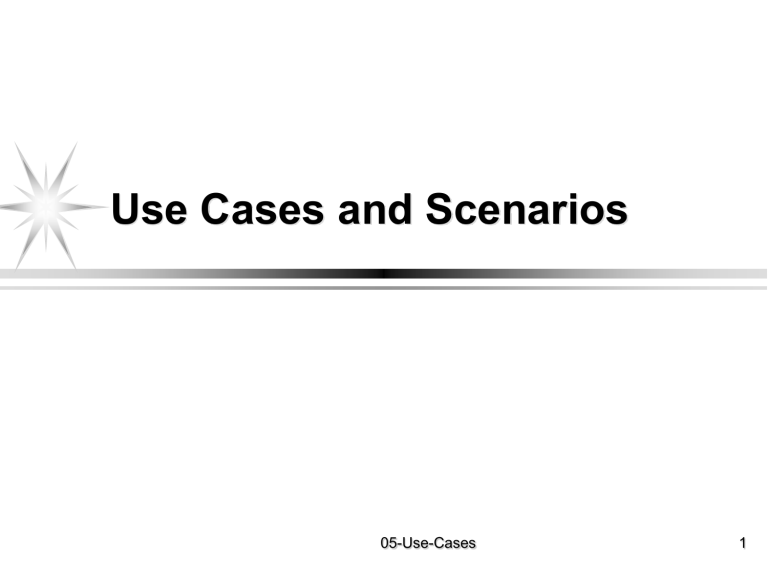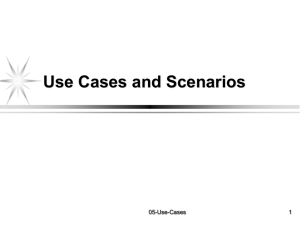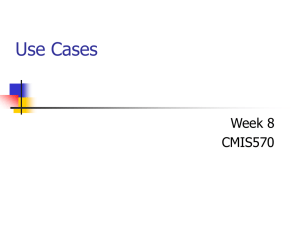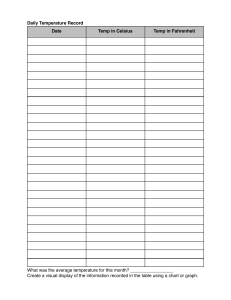
Use Cases and Scenarios 05-Use-Cases 1 We Will Cover What is a use-case Use-Case diagrams Use-case versus user interaction The constructs in the use-case diagrams Capturing the use-case High-level use-case Extended use-case Difference between use case and scenario 05-Use-Cases 2 What is a Use-Case A use-case captures some user visible function This may be a large or small function A use-case achieves a discrete goal for the user Examples Depends on the level of detail in your modeling effort Format a document Request an elevator How are the use cases found (captured or elicited)? 05-Use-Cases 3 User Goals versus User Interactions Consider the following when formatting a document versus Format a document Ensure consistent formatting of two documents The latter is a user goal Define a style Change a style Copy a style from one document to the next Something the user wants to achieve The former are user interactions Things the user does to the system to achieve the goal 05-Use-Cases 4 Goals and Interactions There is a place for both goals and interactions Understand what the system shall do Understand how the user will achieve the goals Capture the user goals Capture user interactions Sequences of user interactions Thus, start with the user goals and then refine the user goals into several (many) user interactions 05-Use-Cases 5 Use-Case Diagrams (POST) POST: Point of Sale Terminal Use Case POST System Boundary Buy Item Log In Cashier Customer Refund a Purchased Item Adapted from Larman “Applying UML and Patterns” 05-Use-Cases 6 Another Example Set Limits Update Accounts Trading Manager Accounting System Analyze Risk «includes» Valuation «includes» Price Deal Trader Capture Deal «extends» Salesperson Adapted from Fowler “UML Distilled” 05-Use-Cases Limit Exceeded 7 Includes and Extends Includes You have a piece of behavior that is similar across many use cases Break this out as a separate use-case and let the other ones “include” it Examples include Valuation Validate user interaction Sanity check on sensor inputs Check for proper authorization 05-Use-Cases Extends A use-case is similar to another one but does a little bit more Put the normal behavior in one use-case and the exceptional behavior somewhere else Capture the normal behavior Try to figure out what can go wrong in each step Capture the exceptional cases in separate use-cases Makes it a lot easier to understand 8 Setting the System Boundary The system boundary will affect your actors and use-cases POST Buy Item Log In Cashier Customer Refund a Purchased Item Adapted from Larman “Applying UML and Patterns” 05-Use-Cases MH 11 A Different Boundary Let us view the whole store as our system Store Buy Item Refund a Purchased Item Customer Adapted from Larman “Applying UML and Patterns” 05-Use-Cases 12 Embedded System “Onion Skin” * Perception/Action Sensors/Actuators Interfaces System 05-Use-Cases 13 Partial POST POST Buy Item Log In Cashier Customer Refund a Purchased Item Start Up Manager Manage Users System Administrator Adapted from Larman “Applying UML and Patterns” And a Lot More MH 05-Use-Cases 14 POST Use-Case Use case: Actors: Type: Description: Buy Item Customer (initiator), Cashier Primary The Customer arrives at the checkout with items to purchase. The Cashier records the purchase items and collects a payment. On completion the Customer leaves with the items 05-Use-Cases 15 POST Expanded Use-Case Use case: Actors: Type: Description: Cross Ref.: Use-Cases: Buy Item Customer (initiator), Cashier Primary and essential The Customer arrives at the checkout with items to purchase. The Cashier records the purchase items and collects a payment. On completion the Customer leaves with the items. Requirements XX, YY, and ZZ Cashier must have completed the Log In use-case 05-Use-Cases 16 The Home Heating System * Temp Sensor Water Pump Water Valve Home Hot Water Controller Burner Fuel Valve 90 80 70 Fuel Off On 60 50 Control Panel Temp Sensor 05-Use-Cases 18 Home Heating Use-Case Diagram Home Heating Power Up Power Down Home Owner Change Temp. MH 05-Use-Cases 19 Home Heating Use-Cases Use case: Power Up Actors: Home Owner (initiator) Type: Primary and essential Description: The Home Owner turns the power on. Each room Cross Ref.: Use-Cases: is temperature checked. If a room is below the the desired temperature the valve for the room is opened, the water pump started. If the water temp falls below threshold, the fuel valve is opened, and the burner ignited. If the temperature in all rooms is above the desired temperature, no actions are taken. Requirements XX, YY, and ZZ None 05-Use-Cases 20 Modified Home Heating Home Heating Temp. High Power Up «includes» «includes» Power Down Adjust Temp «includes» Home Owner «includes» Change Temp. Temp. Low MH 05-Use-Cases 21 Modified: Home Heating Use-Cases * Use case: Power Up Actors: Home Owner (initiator) Type: Primary and essential Description: The Home Owner turns the power on. Cross Ref.: Use-Cases: Perform Adjust Temp. If the temperature in all rooms is above the desired temperature, no actions are taken. Requirements XX, YY, and ZZ Perform Adjust Temp 05-Use-Cases 22 Modified: Home Heating Use-Cases * Use case: Actors: Type: Description: Cross Ref.: Use-Cases: Adjust Temp System (initiator) Secondary and essential Check the temperature in each room. For each room: Below target: Perform Temp Low Above target: Perform Temp High Requirements XX, YY, and ZZ Temp Low, Temp High 05-Use-Cases 23 Modified: Home Heating Use-Cases * Use case: Actors: Type: Description: Cross Ref.: Use-Cases: Temp Low System (initiator) Secondary and essential Open room valve, start pump if not started. If water temp falls below threshold, open fuel value and ignite burner. Requirements XX, YY, and ZZ None 05-Use-Cases 24 Scenarios -- One Use Case Power-up Power-up Ignite burner All temps OK All temps too low Open fuel valve 05-Use-Cases Open valves Start pump 25 Scenarios -- One Use Case Power-up Ignite burner Burner fails All temps too low Open valves Open fuel valve Start pump Shut off fuel 05-Use-Cases Stop pump Notify error 26 HACS Homework assignment and collection are an integral part of any educational system. Today, this task is performed manually. What we want the homework assignment distribution and collection system (HACS for short) to do is to automate this process. HACS will be used by the instructor to distribute the homework assignments, review the students’ solutions, distribute suggested solution, and distribute student grades on each assignment. HACS shall also help the students by automatically distributing the assignments to the students, provide a facility where the students can submit their solutions, remind the students when an assignment is almost due, remind the students when an assignment is overdue. 05-Use-Cases 27 HACS Use-Case Diagram HACS Configure HACS Distribute Asignments Remind Student Get Assignment System Admin Post Solutions Submit Assignment Student Distribute Grade Get Solution Instructor Get Grade MH 05-Use-Cases 28 HACS Use-Cases Use case: Actors: Type: Description: Distribute Assignments Instructor (initiator) Primary and essential The Instructor completes an assignment and submits it to the system. The instructor will also submit the due date and the class the assignment is assigned for. Cross Ref.: Use-Cases: Requirements XX, YY, and ZZ Configure HACS must be done before any user (Instructor or Student) can use HACS 05-Use-Cases 29 Alternate HACS HACS Configure HACS Distribute Asignments System Admin Post Solutions Distribute Grade Student Instructor Remind Student Submit Assignment 05-Use-Cases MH 30 Alternate HACS Use-Cases Use case: Distribute Assignments Actors: Instructor (initiator), Student Type: Primary and essential Description: The Instructor completes an assignment and submits it to the system. The instructor will also submit the delivery date, due date, and the class the assignment is assigned for. The system will at the due date mail the assignment to the student. Cross Ref.: Requirements XX, YY, and ZZ Use-Cases: Configure HACS must be done before any user (Instructor or Student) can use HACS 05-Use-Cases 31 When to use Use-Cases In short, always!!! Requirements is the toughest part of software development Use-Cases is a powerful tool to understand Who your users are (including interacting systems) What functions the system shall provide How these functions work at a high level Spend adequate time on requirements and in the elaboration phase 05-Use-Cases 32 How it Fits Together Preliminary Investigation Report Requirements Specification Use-Cases a. All High Level b. Some Expanded Prototypes Use-Case Diagram Budget, Schedule Draft Conceptual Model Adapted from Larman “Applying UML and Patterns” 05-Use-Cases Glossary (data dictionary) 33


